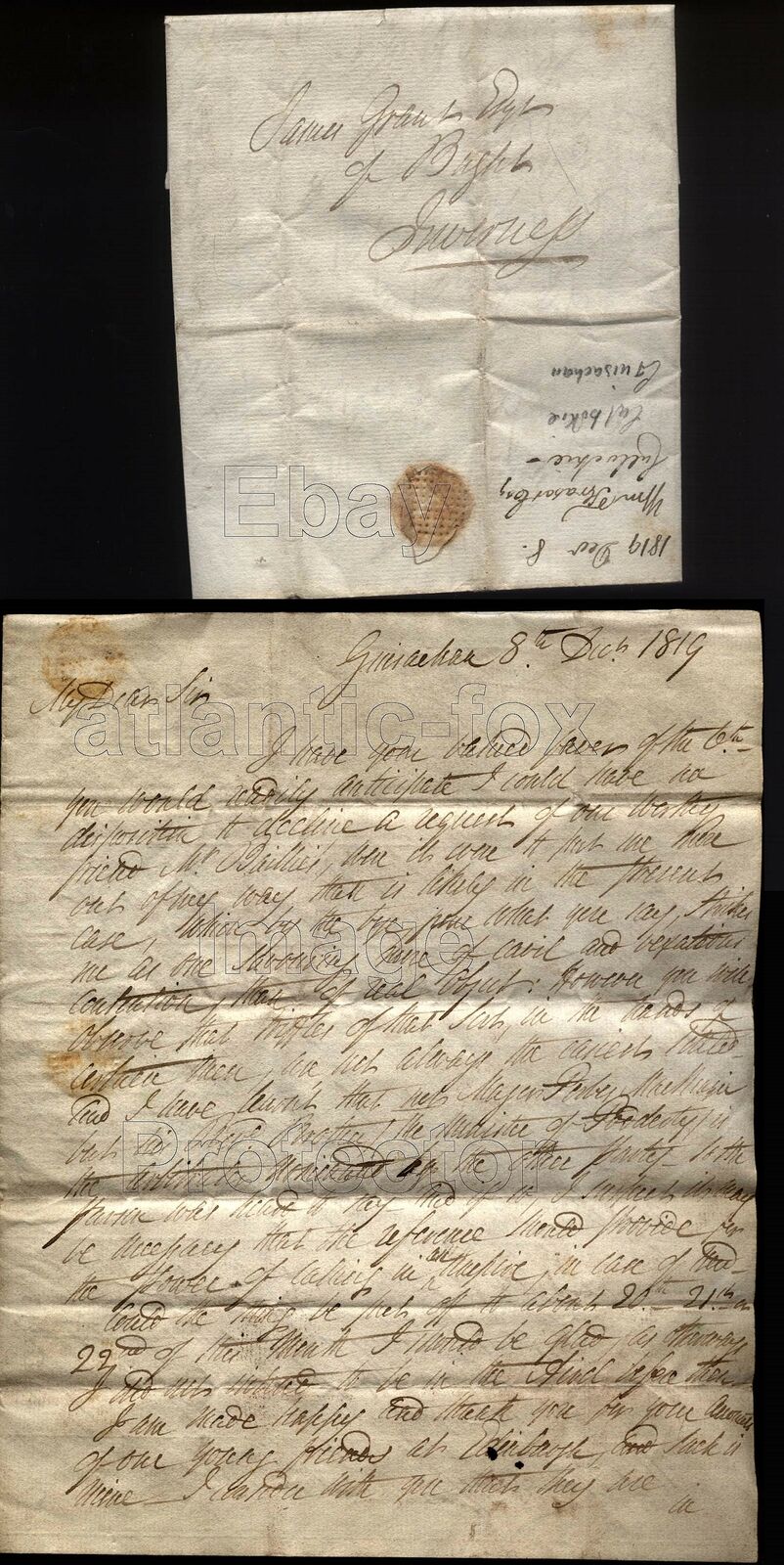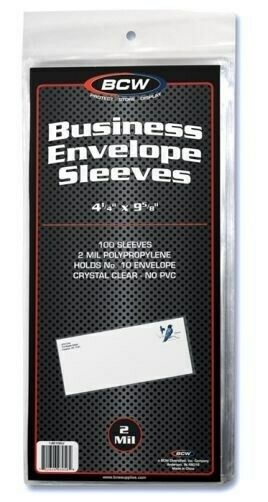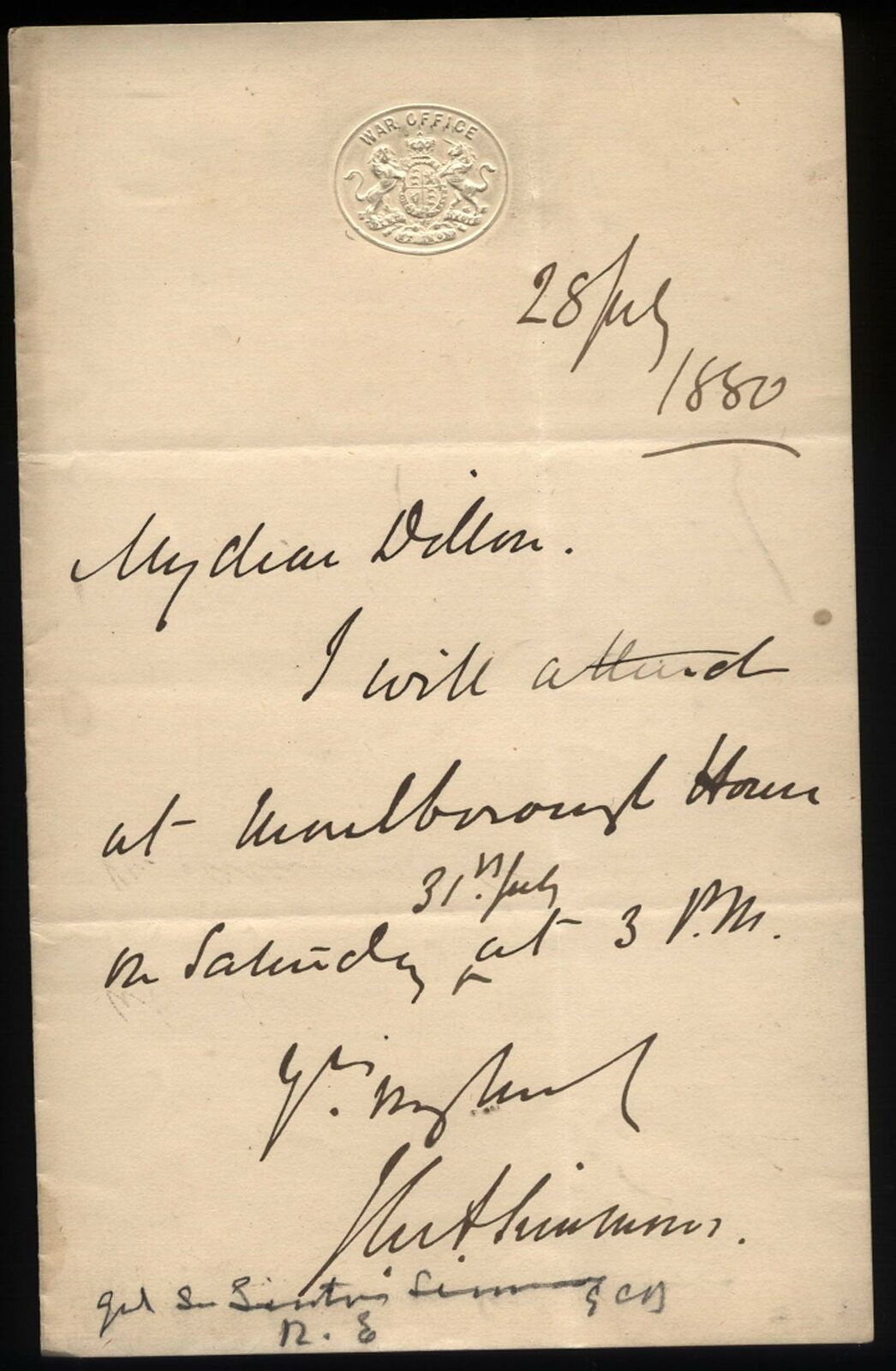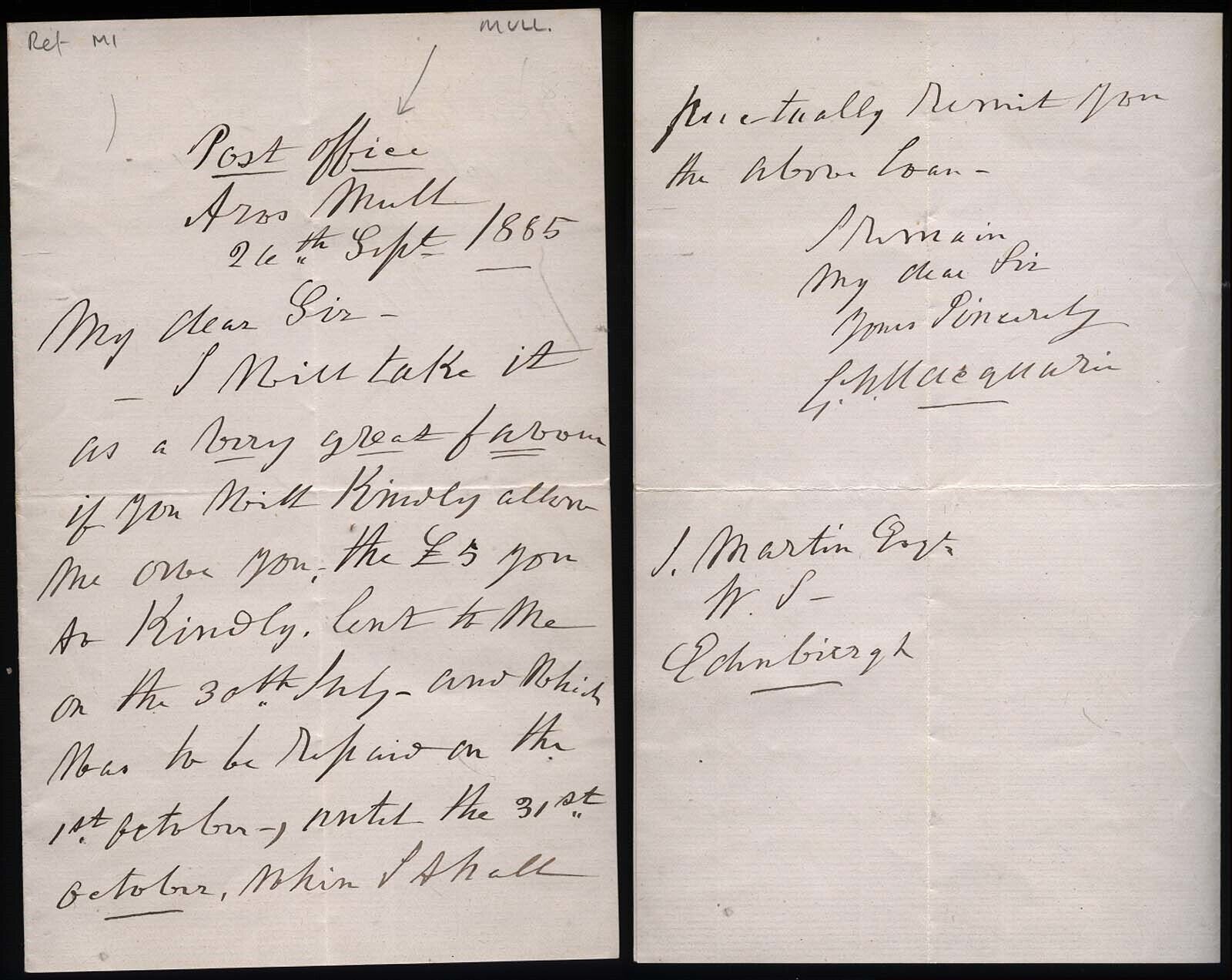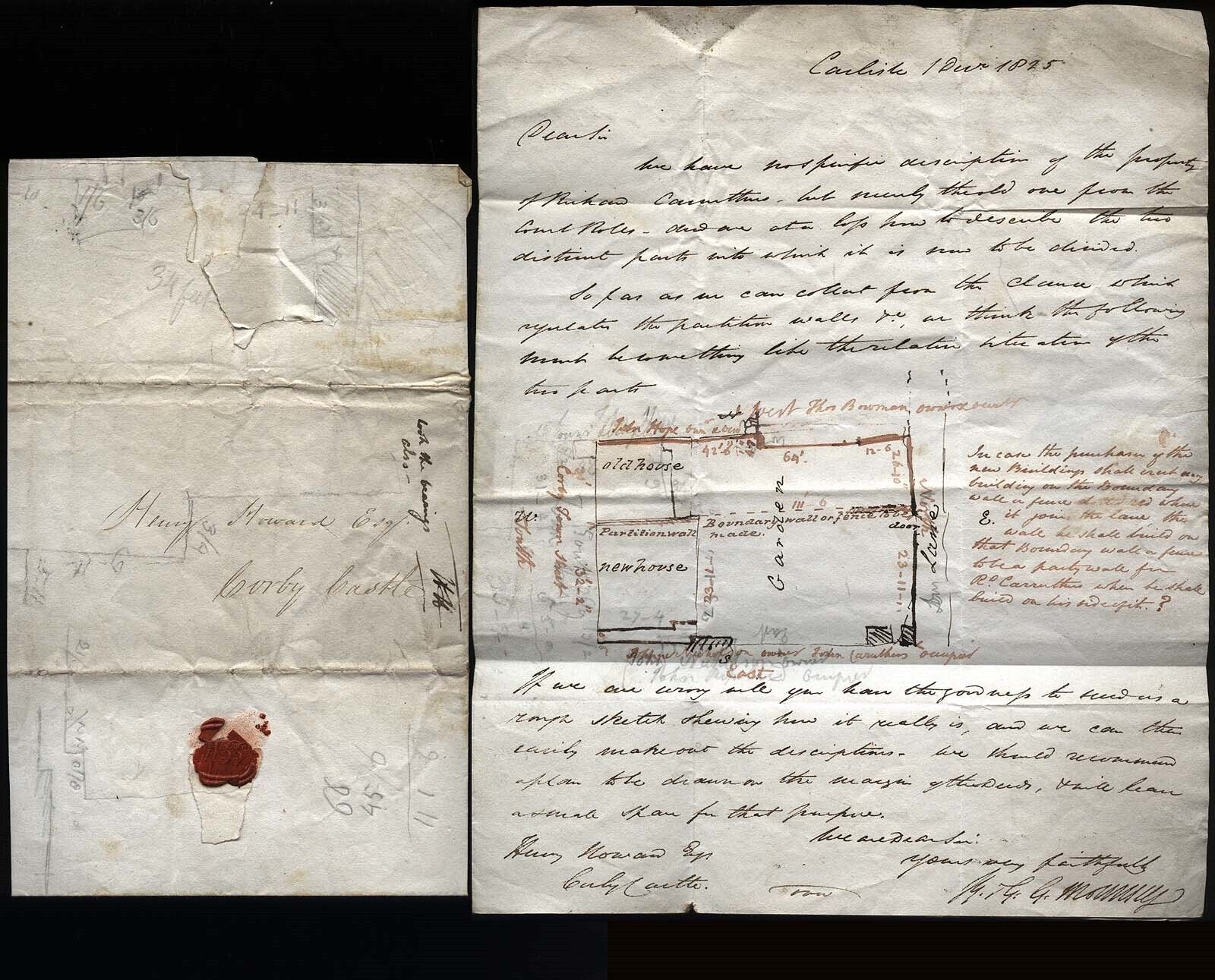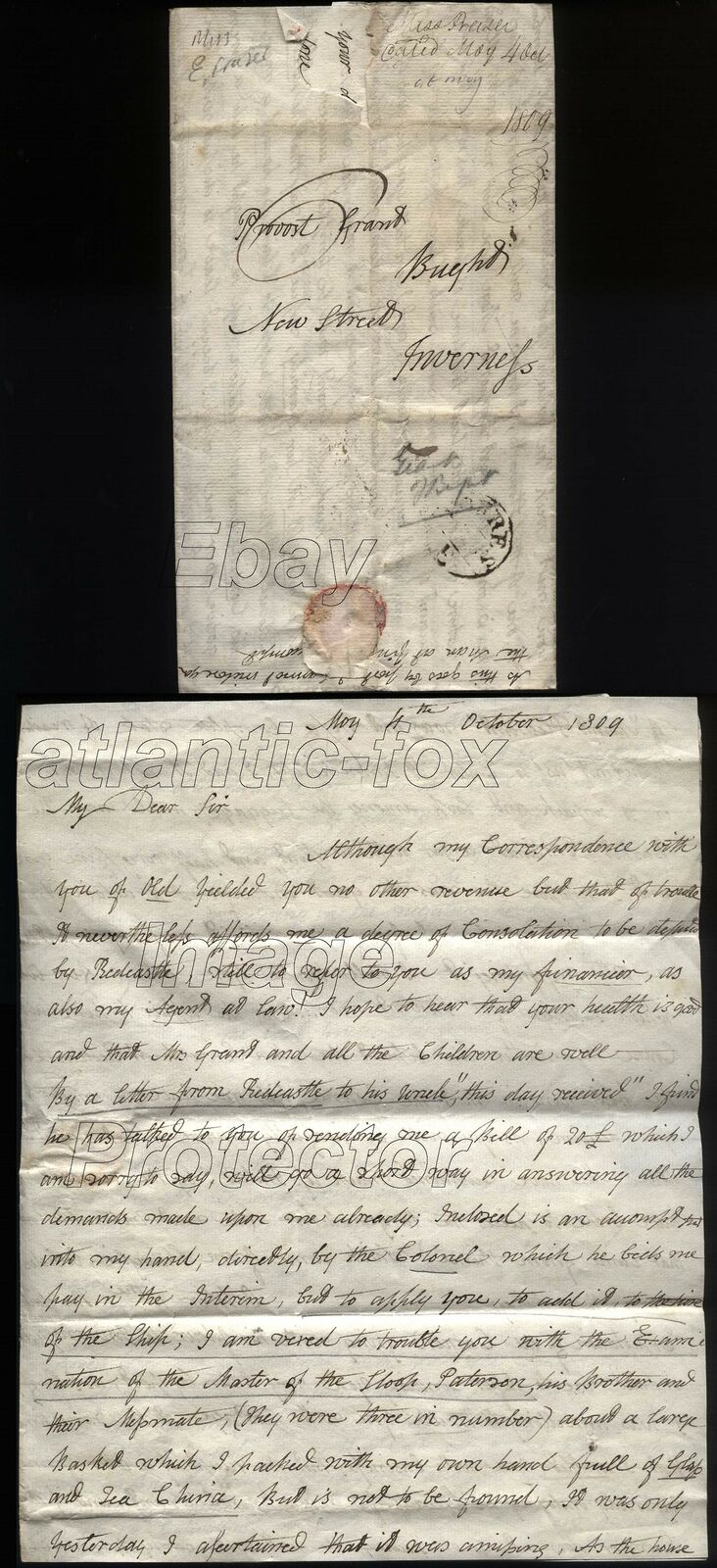-40%
1819 William Fraser of Guisachan House to James Grant of Bught, Inverness
$ 143.96
- Description
- Size Guide
Description
1819 William Fraser of Guisachan House to James Grant of Bught, InvernessThis product data sheet is originally written in English.
Ancestral home of the Golden Retriever Dogs
1819 Fine 4 page letter, William Fraser of
Guisachan
House, 8th Dec to James Grant of
Bught
, Inverness, the former and later Provost of Inverness
William Fraser of
Culbokie
(15th Oct 1763 - 1843)
Biography
William Fraser of
Culbokie
, eldest son of William Fraser of
Guisachan
and
Culbokie
(1723-1797) and Margaret Stuart of
Achnilly
(1731-1797), married his cousin Sarah Fraser and was connected by marriage to a number of other Highland families with interests throughout the Caribbean. Co-owner of Plantation Union estate in British Guiana and judgement creditor of the late Major Charles Grant of
Adelphi
Estate in St Vincent.
Born 15/10/1763 to William Fraser of
Guisachan
and
Culbokie
and Margaret Stuart of
Achnilly
, he joined the army and made money in St Vincent before investing in
Berbice
. In 1797 he married Sarah Fraser, third daughter of Colonel James Fraser of
Belladrum
, a cousin of Hugh Duncan
Baillie
(q.v.) and James
Evan
Baillie (q.v.). Sarah's sister Emilia Fraser married Colin Mackenzie of Mountgerald and their son, also Colin Mackenzie (q.v.), was co-owner of Plantation Union estate in British Guiana with William Fraser. 'He was on his way back to St Vincent [in 1798] when his father died. Writing on the 8th June, 1798, from that place he says- "You may be sure I have the utmost anxiety to bid this part of the world adieu. Mr Fraser-Mackintosh says that "this Culbokie was, perhaps, the best known and had the greatest influence of the family. He was a capital man of business, of active and energetic habits, and I think for some time Convenor of the county."' Both his sons predeceased him and he was suceeded by his grandson William Fraser (1829-).
Sarah Fraser's brothers James, Simon and Evan were active in British Guiana in the late C18, managing the estates of their father James Fraser of Belladrum. William Fraser of Culbokie was the residuary legatee and presumably kinsman of William Fraser of St Vincent, whose will was proved 03/09/1802 and who left legacies among others to Col. James Fraser of Belladrum.
GUISACHAN HOUSE & THE GOLDEN RETRIEVER DOGS
Golden Retriever owners are unfamiliar with the term Guisachan, unless they have made an effort to study the Golden Retriever’s history.Guisachan may be said to have two identities
First, it is the Scottish Highland lands dating back to the 14th century owned by Lord Lovat and then passed along to his son Thomas who in turn passed it on to his son William known as William Fraser, first of Guisachan. The clan history and the passage of the property through several families is well documented in the book Guisachan: A History by Donald Fraser, a Fraser clan descendent. It was first published in 1990 and it is sold by Golden Retriever Clubs throughout the world.
These were stalking lands, where nobleman and local farmers alike, stalked the Monarchs of the Glen, the red deer stags. They were fishing lands too, passed from generation to generation until 1854 when Dudley Coutts Marjoriebanks, later known as Lord Tweedmouth, purchased the property for 60,000 pounds or approximately ,000 US dollars. Other accounts say it sold for 52,000 pounds. At the time of this sale, Guisachan Estate consisted of about 20,000 acres.
Dudley Marjoribanks was created Baron Tweedmouth of Edington on 12 Oct. 1881. Lord Tweedmouth undertook a vast building program during which he built Guisachan House, the mansion now in ruins, as well as several service buildings for the estate. These included a farm steading, a dairy, kennels, stables, a laundry, brewery, meal mill, school (which also served as a church), a meeting house, a hot house, a deer rendering hut, the residences in the village of Tomich and several other dwellings. As Donald Fraser relates, when Lord Tweedmouth died, the estate was passed along to his son Edward the 2nd Lord Tweedmouth, a renown sportsman known for his hospitality and good sportsmanship. Following the death of his wife at Guisachan, heavy financial losses and failing health meant that Lord Tweedmouth lost his love for his Highland Estate and Guisachan, along with other assets, had to be sold. According to Donald Fraser, the details of this sale are not well known, but the estate was purchased by Lord Portsmouth who used it as a recreational site for 27 years. By now, something of an orphaned child, largely uncared for and declining in its beauty, the property was once again put on the market but there were no buyers.
In 1935 the property was sold to Mr. Hunter, who was Lady Aberdeen’s lawyer, she being the daughter of the second Lord Tweedmouth, Edward. This sale perpetuated the demise of the property. Parcels were sold off to several parties including the Forestry Commission, but no one wanted Guisachan House and its 150 acres of land. In 1938 it was rented as a training camp becoming the first Keep Fit Summer School in Britain. But storm clouds were on the horizon. Lady Islington, who resided at the former Tom Guisachan dwelling renamed Hilton Lodge, “was not enamored with the proceedings of the Fitness Campaigners.” Village lore tells of skinny-dipping being a common activity in Hilton Loch, so Lady Islington bought Guisachan House for 1500 pounds, striped it of its furnishings, and had the lead and slates removed from the roof. The denigration of this once lovely mansion was now complete.
Still more of the once grand Guisachan Estate was sold to private owners and to the Forestry Commission. The home farm including the steading and the dairy were sold in the 1950’s to Michael Waddell and on his death in 1960, to Euan Fraser, who in turn sold it to Colonel James Fraser. Colonel Fraser’s son Donald, author of this detailed history, now makes his residence there together with Donald’s son Nigel. The dairy and steading have been converted to self-catering residences known as Tomich Holidays. Lady Islington’s heir still owns the property, but the grand old dame, Guisachan House, sits forlorn among the trees and tall grasses which have overtaken most of the elegant rooms once found there.
That is the story of Guisachan , the property. But Guisachan has a second identity which is far more cheerful in nature. When people speak of “going to Guisachan” or attending the “Guisachan Gathering” it is the mystic of the property to which they are referring. This is the ancestral home of the Golden Retriever and people make pilgrimages to stand in awe before the Guisachan House ruins. It is symbolic of what began here. That first litter of puppies, Primrose, Cowslip, Crocus, sired by Nous, a yellow Wavy-coated Retriever and Belle, a Tweed Water Spaniel became the origins of one of today’s most beloved breed of dogs the world over.
GOLDEN RETRIEVERS
In 1868, Nous, a Wavy-coated Retriever, and Belle, a Tweed Water Spaniel were bred together by Dudley Coutts Marjoribanks, later known as Lord Tweedmouth. Fom that breeding he kept two yellow females, Primrose and Cowslip and gave one male, Crocus, to his son, Edward Marjoribanks. For many decades it was thought that there was a fourth puppy, Ada, but that was subsequently determined to be erroneous. Ada was from a second mating of Nous and Belle and was given to Lord Tweedmouth’s nephew, the 5th Lord Ilchester, beginning the famous Ilchester line of retrievers. Thus it was the offspring of Nous and Belle that became the foundation of the breed subsequently known as, and now universally loved as, the Golden Retriever. The Guisachan dogs were reportedly given only to family and close friends, all of whom were persons of means and title. Lord Tweedmouth kept copious records in the Guisachan Record Book covering 1865 to 1890, a book that only came to light in 1952 when Lady Pentland, a granddaughter of Lord Tweedmouth made it available to the noted English Golden Retriever historian Elma Stonex. In 1952, her friend, the 6th Earl of Ilchester published a famous article in Country Life which, for the first time, gave a complete and accurate history of the development of the breed. The Guisachan dogs were bred to be strong working dogs hunting grouse, partridge and deer.
There are many, many books about the early breeding of both the Guisachan and Ilchester (via Guisachan) lines, the most detailed being the 2011 epic Golden Retrievers: Research into the First Century in the Show Ring by the Australian author, Marilyn Morphet. This 1064 page tome contains a detailed history of the early breedings as well as details of the Marjoribanks (Lord Tweedmouth) family.
The Morphet epic traces the migration of the Golden Retriever from Scotland to other lands beginning as early as 1882 when Archie Marjoribanks, son of Lord Tweedmouth, took Sol to Texas where he established the Rocking Chair Ranch. He took Lady to Canada the following year where he joined the staff of his brother-in-law, Lord Aberdeen. Sol died in Texas but Lady was brought back to England by Archie in 1895. She subsequently had at least one litter.
In 1925, the first two Goldens were exported to Ireland and to India and the same year, an entire litter of Goldens was exported to New Zealand. First two Goldens registered with AKC were in 1925 (Lomberdale Blondin and Dan Hill Judy). A Golden made the journey to Sweden, in 1929 a Golden migrated to Switzerland and in 1930, two Goldens were exported to France. In 1932, two Goldens, including a male named Speedwell Pluto were imported to Canada. Pluto, later Can.Am.Ch. Speedwell Pluto, became the foundation sire for many North
American Goldens. Holland reportedly imported Goldens in 1935, Australia in 1937, Norway in 1954, Denmark in 1957 and Finland in 1959. Today, Goldens may be found the world over and Golden Retriever Clubs from North and South America to China, Australia and beyond foster the breed’s development (See global roster of Golden Retriever Clubs in The Team).
:
Powered by SixBit's eCommerce Solution
1819 Fine 4 page letter, William Fraser of Guisachan House, 8th Dec to James Grant of Bught, Inverness, the former and later Provost of Inverness William Fraser of Culbokie (15th Oct 1763 - 1843)Biography William Fraser of Culbokie, eldest son of William Fraser of Guisachan and Culbokie (1723-1797) and Margaret Stuart of Achnilly (1731-1797), married his cousin Sarah Fraser and was connected by marriage to a number of other Highland families with interests throughout the Caribbean. Co-owner of Plantation Union estate in British Guiana and judgement creditor of the late Major Charles Grant of Adelphi Estate in St Vincent.Born 15/10/1763 to William Fraser of Guisachan and Culbokie and Margaret Stuart of Achnilly, he joined the army and made money in St Vincent before investing in Berbice.
Related Interests
Golden Retriever dogs
EAN
Does Not apply
Country
Scotland
Estate or House name
Guisachan House
Family Surname
Fraser
Scotland County
Inverness-shire
Era
1810-1820
Addressed to
James Grant
Letter From
William Fraser
Document Type
Original Manuscript Letter
Year of Issue
1819
Titled Families
Lord Tweedmouth
